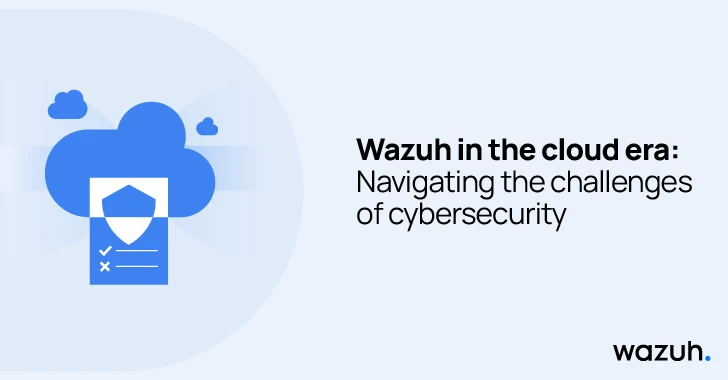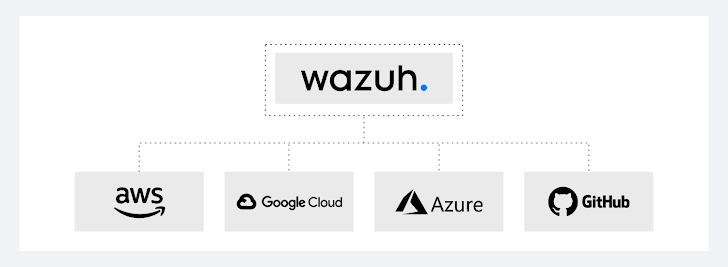
Cloud computing has innovated the way organizations operate and manage IT operations, such as data storage, application delivery, networking, and overall resource management. The cloud offers scalability, adaptability and accessibility, enabling businesses to achieve sustainable growth. However, adopting cloud technologies into your infrastructure presents various cybersecurity risks and challenges that require careful consideration. In this blog post we will explore some cybersecurity challenges in the cloud era. We will also delve into how Wazuh, a cybersecurity solution that supports cloud platforms such as Amazon Web Services (AWS), Microsoft Azure, Github, and Google Cloud Platform (GCP), can help address these challenges effectively.
The rise of cloud computing
Cloud computing delivers services, including servers, storage, software, databases, networks, and intelligence over the Internet”the cloud” to deliver flexible resources, faster innovation and cost efficiency. Cloud computing has seen rapid adoption across industries, revolutionizing the way businesses operate and store their data. With cloud services, organizations can take advantage of the scalability and flexibility offered by cloud providers, eliminating the need for extensive on-premise infrastructure.This move to the cloud allows companies to focus on their core objectives and drive innovation.
The challenges of cloud computing
While cloud computing offers numerous benefits, such as cost savings, increased efficiency, and seamless collaboration, it also introduces unique cybersecurity challenges. Addressing these challenges is critical for organizations venturing into cloud environments.
- Data Privacy and Compliance: One of the most important challenges in the cloud era is ensuring data privacy and regulatory compliance. With data stored and processed in various cloud environments, organizations must ensure compliance with regulations such as GDPR, HIPAA and others. Failure to comply with these regulations can result in serious consequences, including fines and reputational damage.
- Shared responsibility model: Another critical aspect is the shared responsibility model inherent to cloud computing. This cloud computing model means that cloud providers are responsible for protecting the underlying infrastructure, while companies are responsible for protecting their data and applications. While cloud providers can also manage business data and applications, organizations must still have a complete understanding of their responsibilities, implementing security measures to safeguard their assets.
- Multi-cloud environments: The adoption of multi-cloud environments introduces new challenges arising from integration and interoperability between different cloud service providers. These challenges include complexities arising from managing multiple configurations and access controls, security patching gaps, navigating different regulatory frameworks, and inconsistent security visibility across multiple platforms. This challenge requires a focused approach to address the diverse security needs in the multi-cloud landscape.
- Expanded attack surface: As IT resources span multiple cloud and on-premise environments, the risk and potential for cyber attacks increases significantly. The requirement to protect virtual servers, remote applications, containers, and network interactions between environments accompanies being in the cloud.
In addition to the challenges discussed, organizations face other challenges such as lack of knowledge and skills, reliability and availability, cost management and password security. Each of these challenges requires careful consideration and strategic planning to ensure a resilient and secure cloud infrastructure.
Wazuh’s role in cloud security
Wazuh is an open source cybersecurity platform that offers unified XDR and SIEM capabilities to improve the security of on-premises endpoints and cloud workloads. Provides monitoring, detection and alerting of security events and incidents within your environment. Wazuh helps organizations secure their cloud infrastructure effectively and protect themselves from emerging cybersecurity threats with its capabilities and flexible architecture.
Wazuh is adaptable to the dynamic nature of cloud environments. Whether organizations use public, private or hybrid clouds, Wazuh can integrate with their infrastructure, providing real-time threat detection and incident response capabilities. Wazuh protects cloud workloads on platforms such as Amazon Web Services (AWS), Microsoft Azure, Github and Google Cloud.

Wazuh cloud security features
Wazuh offers a range of features tailored to enhance security in the cloud.
- Complete log management: Wazuh offers extensive log management capabilities, allowing organizations to collect, analyze and archive logs from various cloud platforms and applications. By centralizing log data, Wazuh provides valuable insights into potential security incidents and helps organizations meet compliance requirements. These logs which can be collected from both instance and cloud service monitoring are managed and customized based on the cloud platform involved.
- Real-time threat detection and incident response: Wazuh can detect threats in real time. With its monitoring capabilities, Wazuh provides visibility into your cloud environments, allowing you to monitor and detect suspicious activity and security incidents, as well as respond promptly and mitigate potential risks.
- Vulnerability Management: Wazuh simplifies the vulnerability detection process by automating the identification of potential risks. This helps security teams efficiently address critical security issues. Automated vulnerability management significantly reduces the attack surface of your cloud environment, improving your overall security posture.
- Compliance Management: Wazuh audits your cloud infrastructure to ensure regulatory compliance. It offers ready-to-use rules and templates that facilitate compliance checks. Wazuh systematically reviews monitored endpoints, verifying compliance with PCI-DSS, HIPAA, NIST, TSC, CIS and other applicable regulations. Additionally, the Wazuh Security Compliance Auditing (SCA) module allows system administrators to validate alignment with internal policies and standards.

- File integrity monitoring: Ensuring file integrity is important when safeguarding sensitive data across different cloud environments. The Wazuh FIM module offers continuous monitoring, alerting in real time of unauthorized changes to sensitive files and directories. This is vital to maintain data privacy and prevent unauthorized access.
- Scalability: As companies scale their cloud infrastructure, Wazuh can grow with them. The Wazuh architecture allows for scalability by adding more Wazuh core component nodes to your existing infrastructure. This ensures that organizations can monitor and protect their growing cloud environments without compromising performance.
Conclusion
Cybersecurity is critical in this cloud era, where the digital landscape is constantly evolving. As organizations embrace the benefits of cloud computing, they also face the challenges associated with securing their cloud environments. Wazuh provides an effective solution to address the complexities of cybersecurity in the cloud era with its capabilities and flexibility. Using Wazuh, organizations can improve their security posture, detect threats in real time, and protect valuable data and applications.
Wazuh is an open source unified XDR and SIEM platform that monitors endpoints, cloud services and containers. It offers flexibility in integrating with various cloud providers, including Amazon Web Services, Microsoft Azure, and Google Cloud, while offering complete visibility and robust security features.